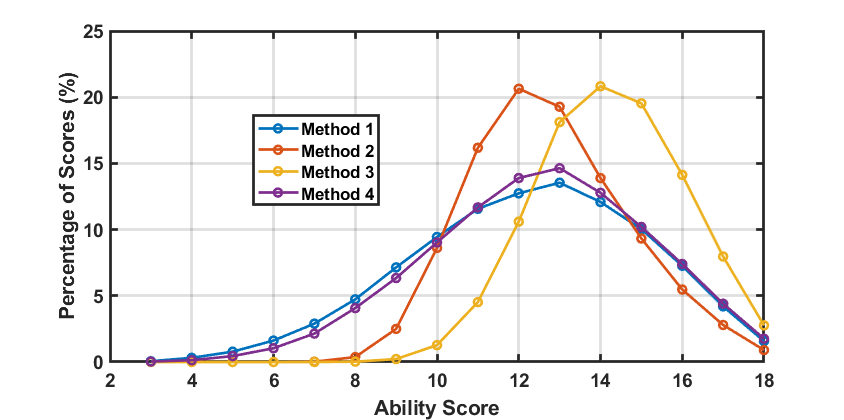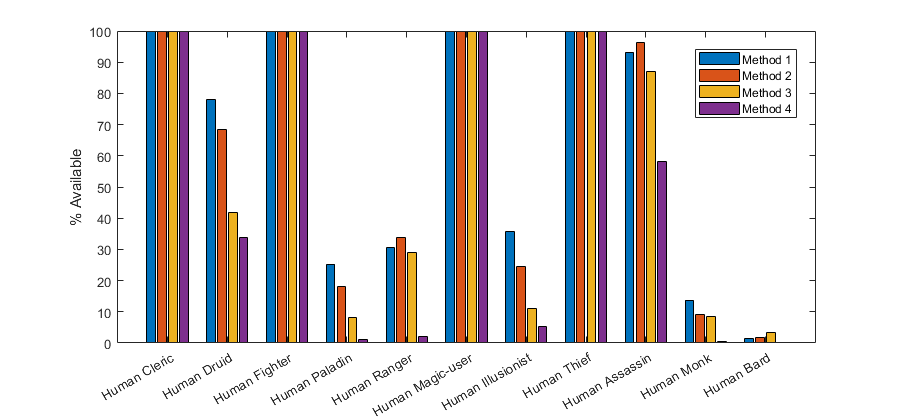At the beginning of the Advanced Dungeons and Dragons Dungeon Master’s Guide are four methods for selecting player ability scores using d6 dice. These methods differ in the amount of player choice they permit, average ability values, and the types of race and classes which are available to the player.
The four methods can be summarized as:
- Method 1: Roll four dice and drop one to get each of the six ability scores. Players can assign scores to abilities as they wish.
- Method 2: Roll three dice twelve times, keep the largest six totals, and assign scores to abilities as the player wishes
- Method 3: Roll three dice six times for each ability, the player cannot re-arrange the scores
- Method 4: Roll twelve sets of six ability scores using three dice for each ability. The player chooses which one they like.
We can use Monte Carlo analysis to generate many sets of ability scores with each method quickly. For Method 4, we assume the set of scores with the highest sum is chosen. I tried to keep the number of graphs to a minimum, just what is needed to illustrate key points.

Looking at these distributions, we can conclude a few things:
- Method 3, which offers the least player choice, offers the most high stat values. This seems like the way to go to encourage people to try new playstyles, while rewarding them with well-rounded characters.
- Method 2 eliminates low scores, with scores under 10 being very rare, but with the caveat that scores above 15 are going to be rare as well. However, it is likely this method will result in clearing most common hurdles for choosing a class.
- Methods 1 & 4 end up looking pretty similar from an ability score standpoint.
However, this is far from the whole story. The choice of method has a large effect on what classes and races are even available to players. We can examine all of the possible player choices for each race and class. Below are the odds of each class being available to the player as a human character.

There are some interesting take-aways here:
- The four basic classes are almost always available with any method.
- The highly flexible methods (1&2) generally provide the most class choices for the player
- As classes become harder to achieve, Method 3’s larger average scores start to offset its lack of flexibility. It is the best method if you want a chance at a bard.
- Method 4 is consistently the toughest method for getting classes with difficult requirements
But what about other races? By and large, the story with other races isn’t much different. The extra restrivtions usually are not that big of a deal. The big thing that crops up is when you have races with maximum stats, Method 3 often means you have to either drop an ability score, or forego being a half-orc or dwarf. For the half-orc, that’s about 75% of the time.
But what about Prime Requisites? Prime requisites follow the same sort of pattern as before, with Method 1 being the best way to get a prime requisite for any class, followed by 2, 3 and 4.
But what about multi-class characters? These follow the same story as single class characters, albiet harder still than non-humans. The real trick here is that getting the full prime requisite is very rare.
Conclusions
Each method offers substantially different outcomes for the players.
Method 1 gives the player lots of choices ability to re-arrange scores, but you will see a wide range of ability scores, the number of bonuses will be limited, and you might have to take some maluses.
Method 2 also offers lots of choices for race and class because of re-arrangement of scores. However, this method will tend to produce more middle-of-the-road scores, with fewer bonuses and maluses than other methods.
Method 3 gives the least player choice, but rewards the player with the best ability scores. Expect to have characters with good ability scores outside the ones which most benefit their class.
Method 4 offers less choice than Methods 1 & 2, and actually suffers from the least access to sub-classes and difficult classes. Player characters will be probably have to accept some malus to get a character which otherwise makes the mark.
My personal conclusion from all of this, is to think about what role this PC is going to play when choosing a method for the player to roll with . If the goal is to play for years and become high level, Method 3 seems right. If the goal is to spin up a hireling to help in someone else’s adventure, Method 4 might be appropriate.